Intel’s Silvermont Architecture Revealed: Getting Serious About Mobile
by Anand Lal Shimpi on May 6, 2013 1:00 PM EST- Posted in
- CPUs
- Intel
- Silvermont
- SoCs
ISA
The original Atom processor enabled support for Merom/Conroe-class x86 instructions, it lacked SSE4 support due to die/power constraints; that was at 45nm, at 22nm there’s room for improvement. Silvermont brings ISA compatibility up to Westmere levels (Intel’s 2010 Core microprocessor architecture). There’s now support for SSE4.1, SSE4.2, POPCNT and AES-NI.
Silvermont is 64-bit capable, although it is up to Intel to enable 64-bit support on various SKUs similar to what we’ve seen with Atom thus far.
IPC and Frequency
The combination of everything Intel is doing on the IPC front give it, according to Intel, roughly the same single threaded performance as ARM’s Cortex A15. We’ve already established that the Cortex A15 is quite good, but here’s where Silvermont has a chance to pull ahead. We already established that Intel’s 22nm process can give it anywhere from a 18 - 37% performance uplift at the same power consumption. IPC scaling gives Silvermont stable footing, but the ability to run at considerably higher frequencies without drawing more power is what puts it over the top.
Intel isn’t talking about frequencies at this point, but I’ve heard numbers around 2 - 2.4GHz thrown around a lot. Compared to the 1.6 - 2GHz range we currently have with Bonnell based silicon, you can see how the performance story gets serious quickly. Intel is talking about a 50% improvement in IPC at the core, combine that with a 30% improvement in frequency without any power impact and you’re now at 83% better performance potentially with no power penalty. There are other advantages at the SoC level that once factored in drive things even further.
Real Turbo Modes & Power Management
Previous Atom based mobile SoCs had a very crude version of Intel’s Turbo Boost. The CPU would expose all of its available P-states to the OS and as it became thermally limited, Intel would clamp the max P-state it would expose to the OS. Everything was OS-driven and previous designs weren’t able to capitalize on unused thermal budget elsewhere in the SoC to drive up frequency in active parts of chip. This lack of flexibility even impacted the SoC at the CPU core level. When running a single threaded app, Medfield/Clover Trail/et al couldn’t take thermal budget freed up by the idle core and use it to drive the frequency of the active core. Previous Atom implementations were basically somewhere in the pre-Nehalem era of thermal/boost management. From what I’ve seen, this is also how a lot of the present day ARM architectures work as well. At best, they vary what operating states they expose to the OS and clamp max frequency depending on thermals. To the best of my knowledge, none of the SoC vendors today actively implement modern big-core-Intel-like frequency management. Silvermont fixes this.
Silvermont, like Nehalem and the architectures that followed, gets its own power control unit that monitors thermals and handles dynamic allocation of power budget to various blocks within the SoC. If I understand this correctly, Silvermont should expose a maximum base frequency to the OS but depending on instruction mix and available TDP it can turbo up beyond that maximum frequency as long as it doesn’t exceed TDP. Like Sandy Bridge, Silvermont will even be able to exceed TDP for a short period of time if the package temperature is low enough to allow it. Finally, Silvermont’s turbo can also work across IP blocks: power budget allocated to the GPU can be transferred to the CPU cores (and vice versa).
By big-core standards (especially compared to Haswell), Silvermont’s turbo isn’t all that impressive but compared to how things are currently handled in the mobile space this should be a huge step forward.
On the power management side, getting in and out of C6 should be a bit quicker. There's also a new C6 mode with cache state retention.


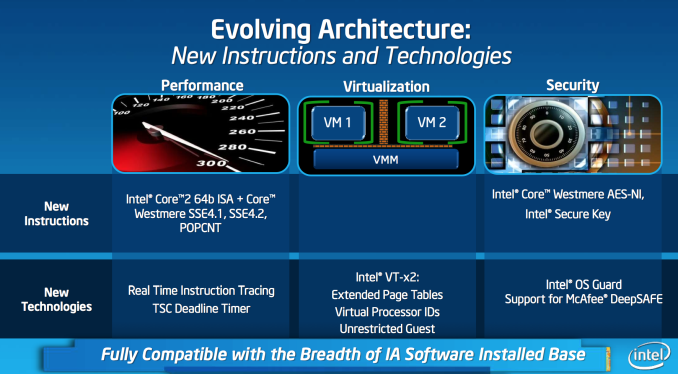
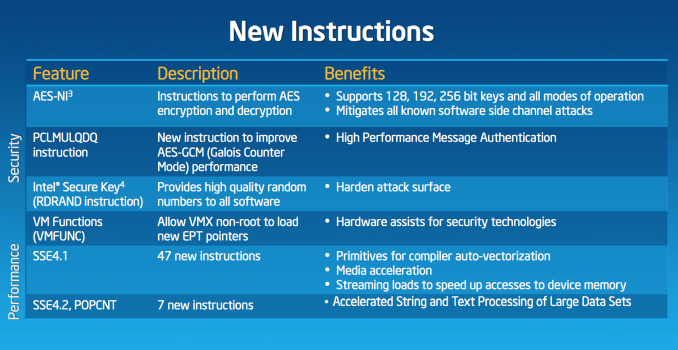
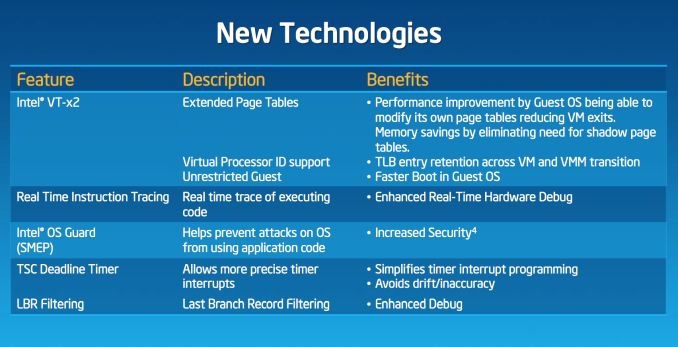
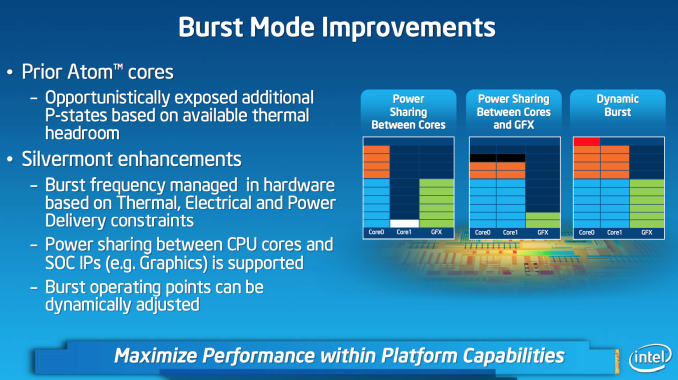
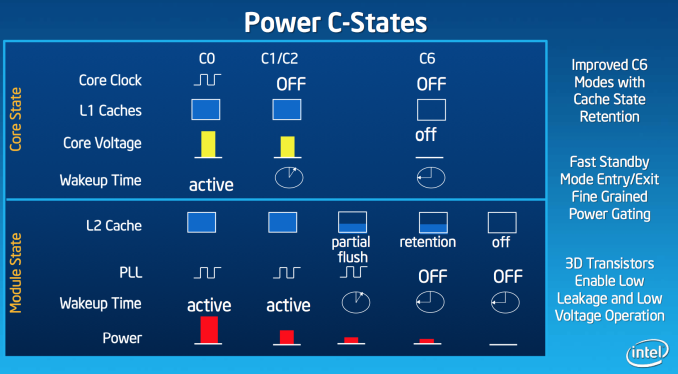








174 Comments
View All Comments
Hector2 - Friday, May 17, 2013 - link
There are only 3 companies right now left in the world who have the muscle and volume to afford high tech fabs -- Intel, Samsung & TSMC. And Intel has about a 2 year lead. That means not just higher performance and lower power than before, but lower cost. Making the chips smaller multiplies the number of chips on a single, fixed-cost wafer and lowers costs. If the chip area is 1/2, the costs to make it are about 1/2 as well. 22nm tech gives Intel faster chips with less power than their competition. 14nm hits it out of the park.BMNify - Wednesday, June 5, 2013 - link
You're absolutely wrong about "lower cost". x86 requires more die area. The process is more volatile (more failed wafers).If we combine the 2 above factors with better performance, lower power consumption and toss in a lack of experience we get GT3e. A technological marvel that few (OEMs) want.
BMNify - Wednesday, June 5, 2013 - link
Spot on Krysto - It's Intel's process advantage that is shining through. Soon they'll hit the point of diminishing returns and/or the rest of the market will catch up/get close enough. When I see AMD at 32nm (Richland) having lower power draw at idle than Intel at 22nm (Ivy Bridge) I wonder how special their "secret sauce" actually is.How long can Intel loss-lead? Probably as long as Xeon continues to make up for it but ARM is getting into the server market now too (looking forward to AMD and Calexda ARM SoCs for the server market). Should be interesting in 3-5 years
TheinsanegamerN - Monday, August 26, 2013 - link
only issue, though, is when you put that richland chip under load. all of a sudden, intel is using much less power.t.s. - Monday, May 6, 2013 - link
"The mobile market is far more competitive than the PC industry was back when Conroe hit. There isn’t just one AMD, but many competitors in the SoC space that are already very lean fast moving. There’s also the fact that Intel doesn’t have tremendous marketshare in ultra mobile."Well, with their 'strategy' back then when facing AMD (http://news.bbc.co.uk/2/hi/8047546.stm), they surely'll win. :p
nunomoreira10 - Monday, May 6, 2013 - link
It´s kinda suspicious that there are many comparisons against arm but none against Amd jaguar or even bobcat.jaguar will probably be a much better tablet cpu and gpu, while intel competes on the phone market.
Khato - Monday, May 6, 2013 - link
Which AMD Jaguar/Bobcat SKU runs at 1.5 watts? They aren't included in the comparison because they're a markedly higher power level.nunomoreira10 - Monday, May 6, 2013 - link
they will both be used on fan-less tablet designs...extide - Tuesday, May 7, 2013 - link
Totally different markets. Jaguar/Bobcat will likely line up next to low end Core/Haswell, not an Atom/SilvermontPenti - Tuesday, May 7, 2013 - link
Both will sadly be way to underpowered when it comes to the GPU, and that matters greatly on general OS's and applications like running a desktop OS X or Windows (or GNU/Linux) machine. You won't really be able to game on them at all as it's not smartphone games people want to run. GPGPU won't really be fast enough for anything and we talk about ~100-200 GFLOPs GPU-power on the AMD side for what is essentially a full blown computer.Intel is clearly targeting the phone market. Something AMD/ATI divested from years back with their mobile GPU tech going to Qualcomm (Adreno, which isn't Radeon-based) and Broadcom. ATIs/AMDs mobile GPU-tech was before that previously licensed to or used together with the likes of Intel (PXA/XScale – not integrated though), Samsung and Freescale among others. Their technology already is the mainstay of the mobile business and was departed from the company but in effect their technology know how was successful in the market without their leadership so why would they compete with that, of course they wouldn't.
AMD simply has not and will not likely any time soon invest in an alternate route to dominate their own part of the smartphone/ARM-tablet market while Intel has with integrated designs replacing the custom ARMv5TE design. AMD going after ARM-business is different since they will license the core and their manufacturer GloFo already does manufactures and even offers hard macros for ARM-designs that they sell a bunch of to other customers already. It's also going after other embedded fields and the emerging ARM-server/appliance space all without designing custom cores.
While PXA (Intel) was quite successful in the market, moving to x86 and doing away with stuff like ARM-based network processors, raid-processors allows Intel to focus on delivering great support for modern ISA across all sorts of devices, while it didn't make it into phones (until lately) like PXA which continued to power Blackberrys under Marvell, was the main Windows Mobile platform for years after Intels departure and so on it was able to become a multimediaplatform, and a widely adopted chip for embedded use, driving NAS-devices and the like. Thanks to the Intel purchase of Infineons Wireless portfolio including many popular 3G radios/modems and them forming a new wireless division their actual business and sales in the mobile market is also much higher than when they still had their custom PXA/XScale lineup. Plus they couldn't have competed with their XScale lineup without designing new ARM-ISA compatible cores/designs to be able to match Cortex A8, A9, A7, A15, Krait 600 etc. Plus puts them in a much better place to be a wireless/terminal supplier when they can support customers who want advanced wireless modems/baseband, Application processors, bt, wifi etc. While Nvidia will have Tegra 4i with integrated modem AMD couldn't offer anything similar as they have no team capable of producing radio baseband. Having modern compilers and x86-ISA sure makes it convenient now for Intel, as well as integrating their own GPU, just licensing ARM Ltd designs wouldn't have put them in a better position to continue their presence in the mobile field. They have basically developed and scaled their desktop GNU/Linux drivers in the Linux Kernel, added mobile features and so on years before they put the hardware and can leverage that software in mobile platforms (Android) but it makes sense and they don't have to rely on IP cores and third party drivers for graphics with the coming Bay Trail. They couldn't have shared that much tech if they were anything else then x86. Of course AMD won't be in the same place and scaling down a GPU designed for thousands of stream processors and Windows/OS X drivers to put it into phones is not the same. It would be awful if it is just scaled down to fit the power usage, even if Nvidia has kinda custom mobile gpu it's still worse then the competitors which has no presence in desktop computing. Drivers for QNX, Android/Linux, iOS etc is not the same as with Windows either. It takes a long time to start over when they did away with an okay solution (z460), and they haven't but other have and thats fine, there is more competition here then elsewhere. x86 is no stopper for Intel.